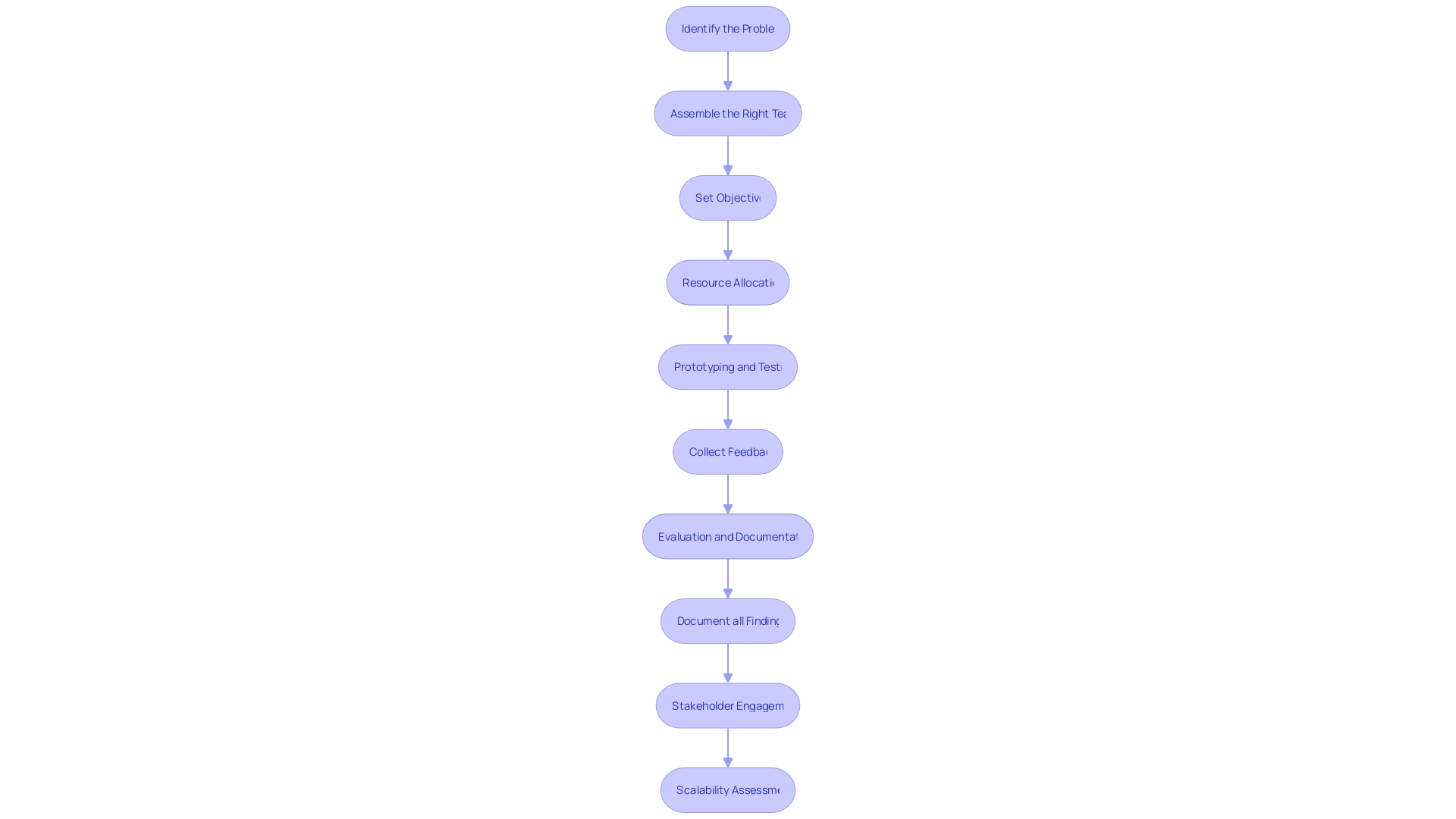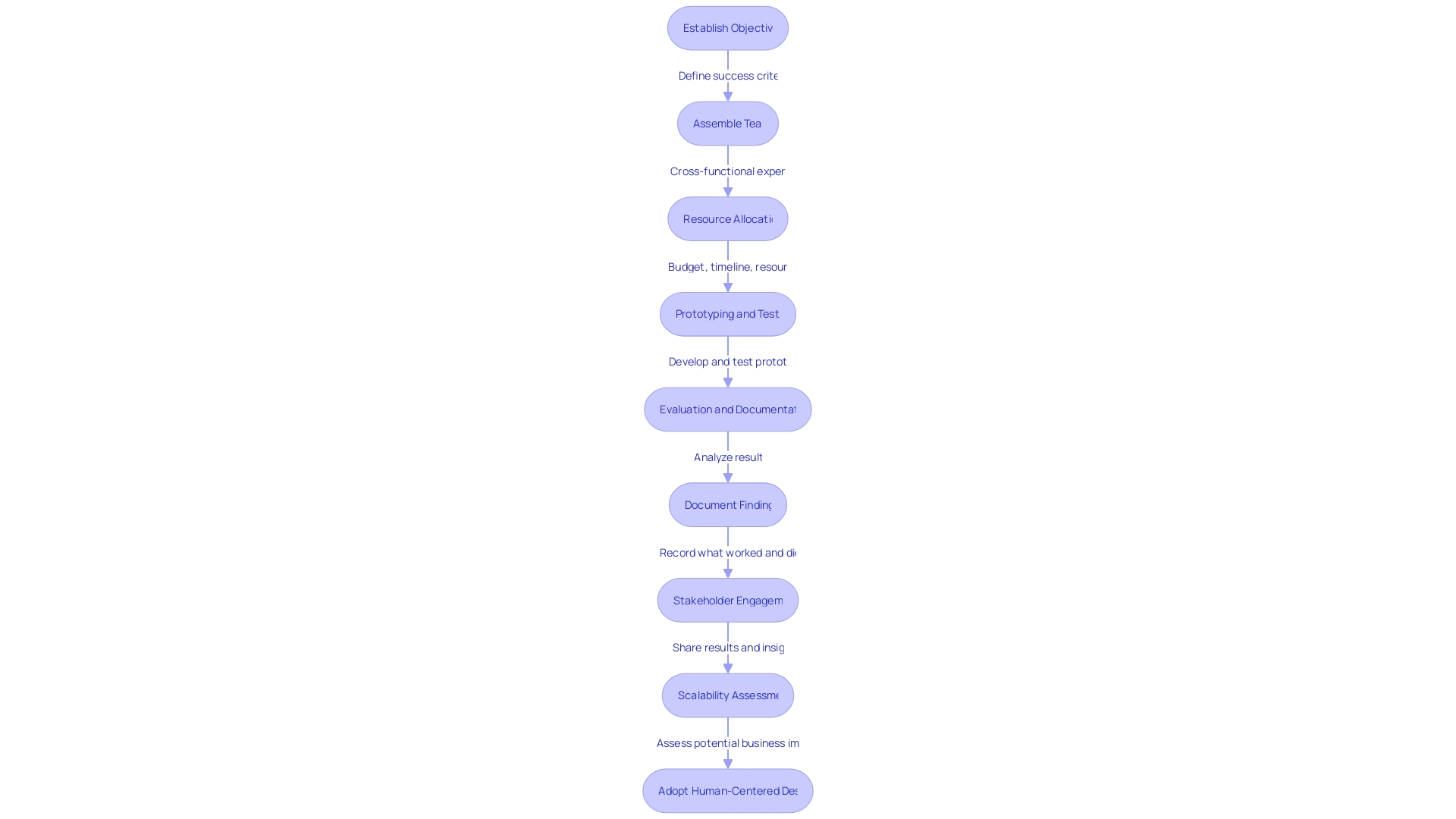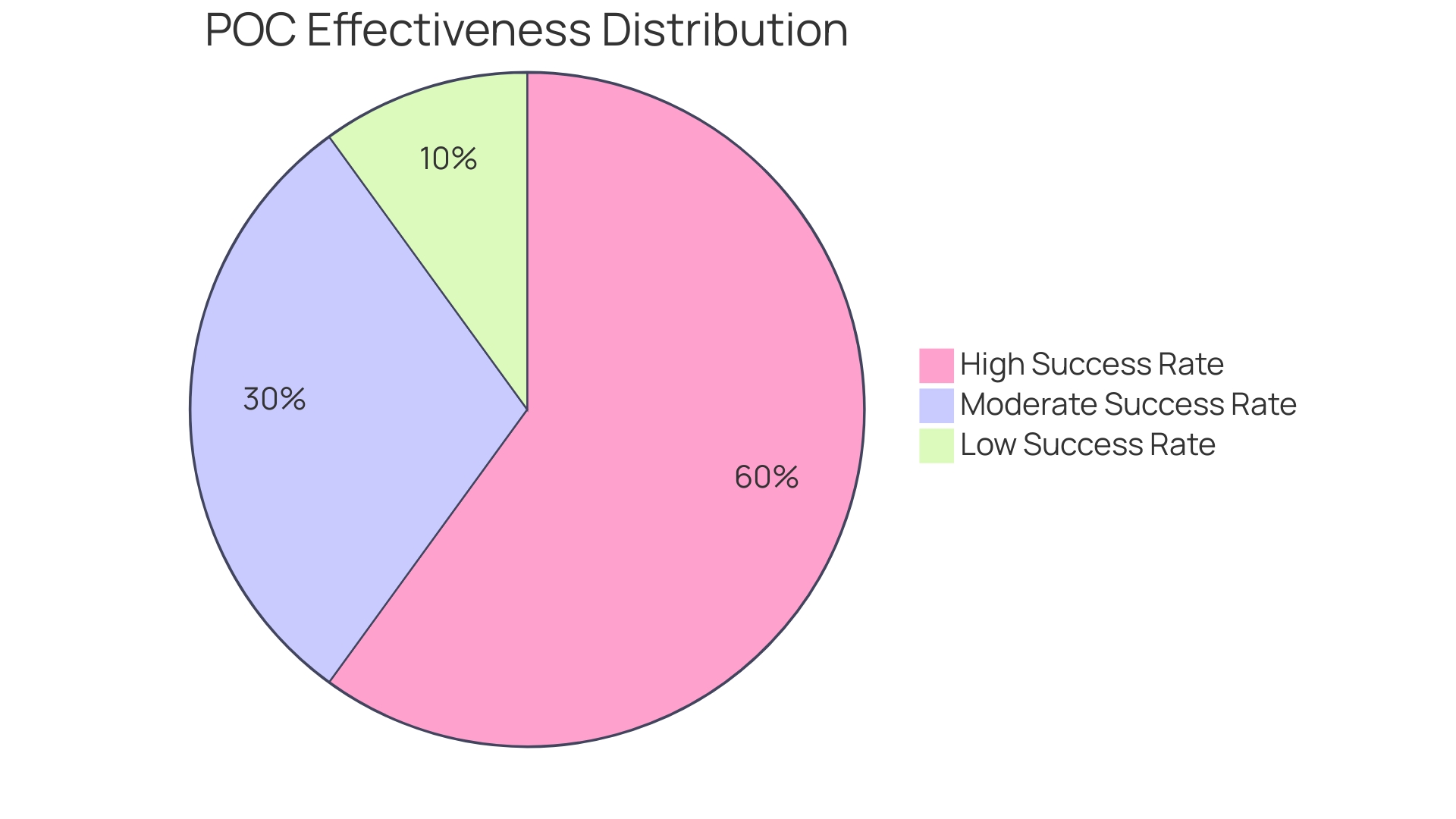Introduction
A Proof of Concept (PoC) plays a crucial role in determining the viability of a product, service, or idea before it's fully developed. It serves as a litmus test for innovative ideas, addressing urgent customer problems and providing valuable early feedback.
In this article, we will explore the different types of Proof of Concept projects, the benefits of using this approach in business, best practices for creating a successful PoC, and real-world examples of successful PoC implementations. By understanding the impact of PoCs on business growth and innovation, we can harness their power to drive success in a rapidly changing landscape.
Understanding the Role of POC in Business
A Proof of Concept (PoC) serves as a litmus test for innovative ideas, playing a pivotal role in determining the viability of a product, service, or idea before it's fully developed. By focusing on a specific 'hair on fire' problem—a term coined by Michael Siebel—a PoC addresses urgent issues for which customers are actively seeking solutions, even if they are preliminary.
Customers facing significant financial losses, existential threats, or who have exhausted other options are more likely to engage with a PoC, providing valuable early feedback. The execution of a PoC demands a clear set of objectives and the assembly of a cross-functional team, ensuring diverse expertise contributes to its success.
This not only mitigates risks by revealing potential challenges early on but also fosters a culture of creativity and problem-solving within the organization. Adam Grant, in his book 'Originals', advocates for the generation of numerous ideas to find a breakthrough, accepting that most will be discarded in the search for success.
This approach underscores the importance of PoCs in filtering out the best ideas through trial and error. Moreover, statistics show that diverse management teams are linked to 19% higher innovation revenue, emphasizing the need for varied perspectives in the ideation and PoC stages. However, over 50% of tech professionals report age discrimination as a barrier, highlighting the need for inclusivity in all aspects of business innovation. Ultimately, a PoC is more than just a prototype; it is a strategic tool that enables businesses to test, learn, and evolve with market needs, ensuring they invest wisely and build confidence among stakeholders.

Types of Proof of Concept Projects
Proof of Concept (POC) projects are essential for businesses to validate their innovative ideas and strategies effectively. These projects can be classified into three main categories: technological Pics that assess the feasibility of new technologies, market Pics that gauge potential customer response and demand, and process Pics that test the efficiency of new operational procedures.
For instance, a hotel looking to enhance its food and beverage sales might undertake a market POC by leveraging its central location to attract more diners, as demonstrated by a major branded hotel that experienced an increase in sales following such a strategy. This aligns with the insights of Jason Fried, co-founder of 37Signals, who emphasizes the importance of getting products into customers' hands quickly for real-world validation over theoretical interviews.
Furthermore, innovation decisions are inherently risky, with a 50% chance of failing to meet expectations. Yet, the top-performing companies have a success rate of 76% in making innovation decisions, showing that a well-executed POC can significantly influence the outcome. Therefore, companies embarking on POC projects should meticulously plan and execute their strategies, gathering evidence and insights, to enhance the likelihood of success and drive growth.

Benefits of Using Proof of Concept
Embracing the Proof-of-Concept (POC) approach in business is akin to assembling a dynamic duo like Lennon and McCartney, where the synergy of collaboration can lead to extraordinary outcomes. As demonstrated by companies like Going, which achieved significant conversion results with Unbounce's A/B testing, and the transformation of the traditional bank guarantee process into a more efficient system, POC is a powerful tool for innovation and differentiation.
It allows businesses to mitigate risks by testing ideas in a controlled environment, which is essential given that innovation decisions have a 2.5 times higher likelihood of failing compared to regular business decisions. The key to escaping the Proof-of-Concept Trap and fostering human-centered innovation lies in creating a culture that embraces learning and experimentation.
Failure must be viewed as a stepping stone, not a roadblock. This mindset, supported by the insights from Adam Grant's 'Originals', suggests that success often requires going through a high volume of ideas and learning from the discarded ones.
Innovation leaders are thus encouraged to foster an environment where taking calculated risks is rewarded, and iterative development is the norm. Furthermore, the strategic use of technologies such as AI, IoT, and cloud computing can propel companies to new heights. By prioritizing human needs and experiences, businesses can enhance their products and services, ensuring that they not only meet but exceed market expectations. This customer-centric approach, paired with strong leadership and innovative tools, as praised by leaders from Allianz, Merck, and MBooth & Associates, positions companies to convert Pics into successful, market-ready innovations.
Creating a Proof of Concept: Best Practices
Developing a Proof of Concept (PoC) is a critical step for businesses to validate the feasibility of their ideas. It is a preliminary experiment that not only tests the technical aspects of a concept but also ensures alignment with strategic objectives. To effectively execute a PoC, it's paramount to establish clear, measurable objectives that can serve as benchmarks for performance.
This structured approach allows for regular reviews and adjustments, fostering an environment where innovation is not just encouraged but strategically managed. In the highly regulated financial sector, for instance, PoCs have been instrumental in transforming complex technical data into accessible formats for user engagement. The success of such projects hinges on the ability to present information in ways that motivate users to explore autonomously, as seen in the case of a Danish company serving the European banking sector.
By starting small and focusing on key metrics, businesses can mitigate risks and maximize cost efficiency. This is especially relevant in the competitive startup landscape, where the ability to stand out and manage growth effectively is crucial. A PoC offers a controlled environment to identify potential challenges early on, enabling companies to make informed decisions and refine their concepts iteratively.
Furthermore, adopting a human-centered design approach can prevent the so-called 'Proof-of-Concept Trap', where companies get stuck in a cycle of experimentation without progressing to customer-ready solutions. By understanding users' needs and putting their experiences at the forefront, companies can avoid innovation fatigue and wasted resources. This approach, combined with a culture that views failure as a learning opportunity, empowers teams to develop breakthrough solutions that are both innovative and aligned with market demands.

Real-World Examples of Successful POC Implementations
Innovative applications of technology are transforming various industries, and Tesla's energy solutions are a prime example. Hector Veiga Ortiz, a Staff Distributed Systems Engineer at Tesla, emphasizes the critical role of data observability in managing the grid's reliability, especially during extreme weather events like Hurricane Ian and the California heat waves.
Tesla's approach to energy, particularly in the face of such challenges, showcases the importance of robust infrastructure to withstand increased demands and ensure operational continuity. Meanwhile, advancements in Tesla's autonomous driving technology demonstrate a commitment to overcoming complex challenges, as highlighted by the iterative improvements in their Full Self-Driving software.
The evolution of this technology, despite setbacks like phantom braking incidents, continues to push the boundaries of what's possible in vehicle automation. Tesla's recent policy change, allowing a one-time transfer of Full Self-Driving software to a new vehicle purchase, reflects an understanding of consumer interests and a strategy to maintain market momentum. These examples underscore the importance of continuous innovation and customer-centric policies in maintaining industry leadership. As technology progresses, companies like Tesla are at the forefront, navigating the intricacies of technical development, consumer expectations, and operational demands to deliver groundbreaking solutions.
The Impact of POC on Business Growth and Innovation
In the dynamic realm of business, the concept of Proof of Concept (POC) is not just a mere step in the innovation process but a critical strategy that can pivot a company towards sustainable and inclusive growth. The implementation of POCs is a testament to a company's commitment to holistic impact, addressing financial, operational, and notably, environmental and social dimensions of business.
Our extensive research underscores the correlation between diverse leadership and heightened social and environmental impact scores, suggesting that POCs driven by multifaceted teams are more likely to yield positive community and ecological outcomes. Moreover, in light of recent economic trends, where individuals have filed a record 2.7 million new business applications in the first half of 2023, Pics become even more vital.
They serve as a beacon guiding these emerging businesses, especially in the context of the significant contributions by Black entrepreneurs to the economy's resilience. The effectiveness of POCs is further emphasized by the stark contrast in innovation success rates among companies.
A survey reveals that top-performing companies have a 76% success rate in innovation decisions, a figure 2.5 times higher than the bottom half. This success is pivotal in transforming company culture, encouraging cross-specialization collaboration, and fostering a feedback-rich environment that includes diverse perspectives. The data suggests that a well-executed POC not only accelerates decision-making and enhances product development but also significantly contributes to increased customer satisfaction and competitive advantage. As companies navigate the pressures of evolving market demands, technological advancements, and shifting customer preferences, POCs stand as a strategic tool to navigate these changes, creating value and driving business success in a rapidly transforming landscape.

Conclusion
In conclusion, Proof of Concept (PoC) projects are crucial for businesses to validate innovative ideas before full development. They serve as a litmus test, addressing urgent customer problems and providing early feedback.
Successful PoCs significantly influence the success rate of innovation decisions. There are three main types of PoC projects: technological, market, and process.
Each type validates different aspects of a business idea. Well-executed PoCs can have a success rate as high as 76% for top-performing companies.
The benefits of using PoCs in business are numerous. They allow companies to test ideas in a controlled environment, mitigate risks, and exceed market expectations by prioritizing customer needs.
Creating a culture that embraces learning and experimentation is key to fostering human-centered innovation. When creating a PoC, it is essential to establish clear objectives, regularly review progress, and focus on key metrics for cost efficiency.
Adopting a human-centered design approach prevents wasted resources and innovation fatigue. Real-world examples like Tesla's energy solutions highlight the importance of continuous innovation and customer-centric policies in maintaining industry leadership. The impact of PoCs on business growth and innovation is significant. They pivot companies towards sustainable growth while addressing environmental and social dimensions. In an increasingly competitive landscape with emerging businesses led by Black entrepreneurs, PoCs become even more vital in guiding their success. In conclusion, PoCs are strategic tools that accelerate decision-making, enhance product development, increase customer satisfaction, and drive business success. By effectively harnessing their power, businesses can navigate market demands while creating value for stakeholders.





